Page 287 of 387
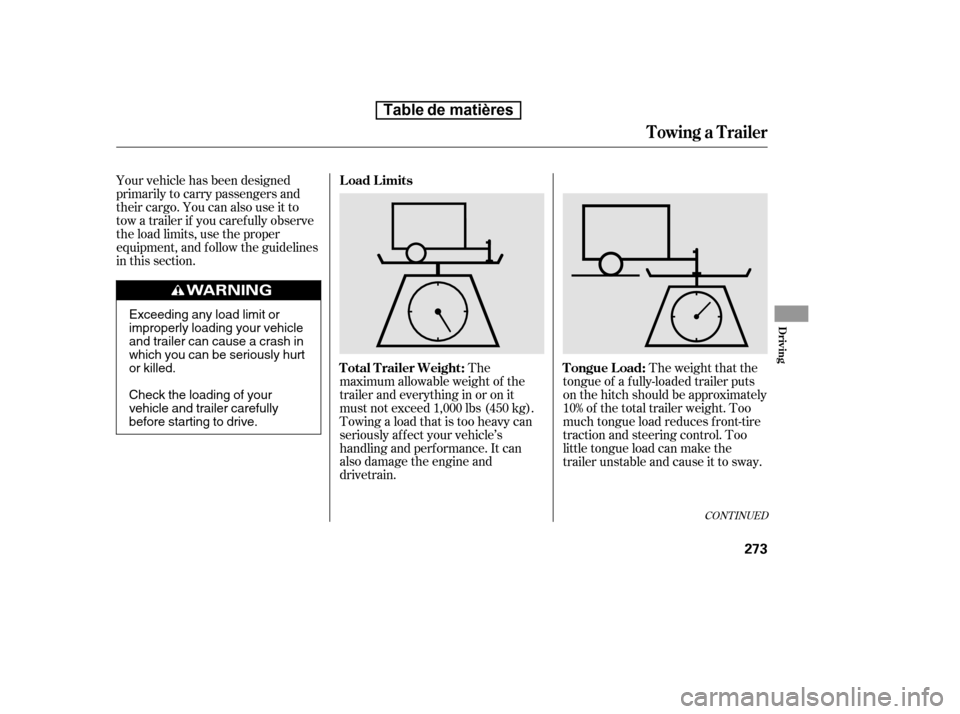
Your vehicle has been designed
primarily to carry passengers and
their cargo. You can also use it to
tow a trailer if you caref ully observe
the load limits, use the proper
equipment, and f ollow the guidelines
in this section.The
maximum allowable weight of the
trailer and everything in or on it
must not exceed 1,000 lbs (450 kg).
Towing a load that is too heavy can
seriously af f ect your vehicle’s
handling and perf ormance. It can
also damage the engine and
drivetrain. Theweightthatthe
tongue of a f ully-loaded trailer puts
on the hitch should be approximately
10% of the total trailer weight. Too
much tongue load reduces f ront-tire
traction and steering control. Too
little tongue load can make the
trailer unstable and cause it to sway.
CONT INUED
Load Limits
T otal T railer Weight: T ongue L oad:
Towing a Trailer
Driving
273
Exceeding any load limit or
improperly loading your vehicle
and trailer can cause a crash in
which you can be seriously hurt
or killed.
Check the loading of your
vehicle and trailer carefully
beforestartingtodrive.
Table de matières
Page 288 of 387
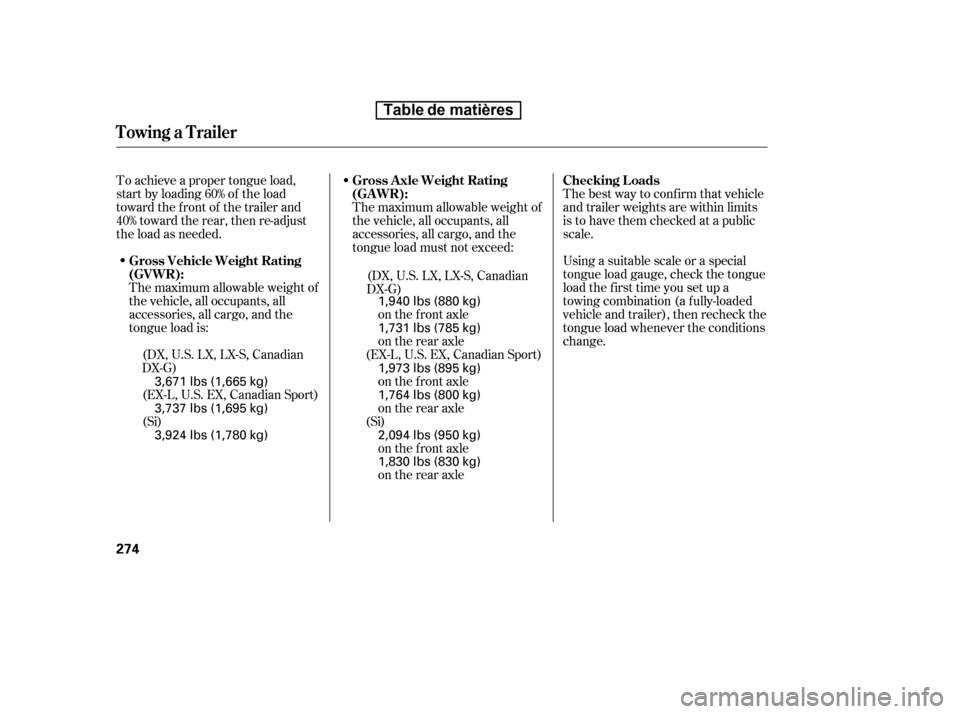
To achieve a proper tongue load,
start by loading 60% of the load
toward the front of the trailer and
40% toward the rear, then re-adjust
the load as needed.The best way to conf irm that vehicle
and trailer weights are within limits
is to have them checked at a public
scale.
Using a suitable scale or a special
tongue load gauge, check the tongue
load the f irst time you set up a
towing combination (a f ully-loaded
vehicle and trailer), then recheck the
tongue load whenever the conditions
change.
The maximum allowable weight of
the vehicle, all occupants, all
accessories, all cargo, and the
tongue load is: The maximum allowable weight of
the vehicle, all occupants, all
accessories, all cargo, and the
tongue load must not exceed:
on the f ront axle
on the f ront axle
on the rear axle
on the rear axle
on the rear axle
on the f ront axle
(Si) (Si)
(DX, U.S. LX, LX-S, Canadian
DX-G)
(EX-L, U.S. EX, Canadian Sport) (DX, U.S. LX, LX-S, Canadian
DX-G)
(EX-L, U.S. EX, Canadian Sport) Checking L oads
Gross Vehicle Weight Rating
(GVWR): Gross Axle Weight Rating
(GA WR):
Towing a Trailer
274
3,671 lbs (1,665 kg)
1,731 lbs (785 kg)
1,940 lbs (880 kg)
3,737 lbs (1,695 kg)
3,924 lbs (1,780 kg) 1,973 lbs (895 kg)
1,764 lbs (800 kg)
2,094 lbs (950 kg)
1,830 lbs (830 kg)
Table de matières
Page 289 of 387
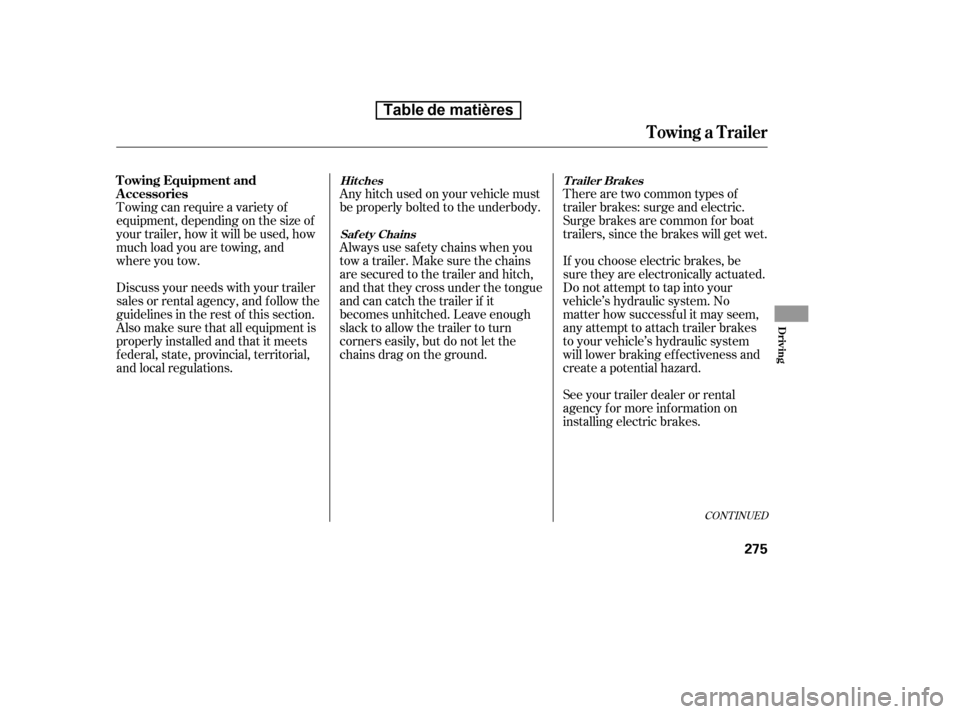
Towing can require a variety of
equipment, depending on the size of
your trailer, how it will be used, how
much load you are towing, and
where you tow.If you choose electric brakes, be
sure they are electronically actuated.
Do not attempt to tap into your
vehicle’s hydraulic system. No
matter how successf ul it may seem,
any attempt to attach trailer brakes
to your vehicle’s hydraulic system
will lower braking ef f ectiveness and
create a potential hazard.
Seeyourtrailerdealerorrental
agency f or more inf ormation on
installing electric brakes.
Discuss your needs with your trailer
sales or rental agency, and f ollow the
guidelines in the rest of this section.
Also make sure that all equipment is
properly installed and that it meets
f ederal, state, provincial, territorial,
and local regulations. Any hitch used on your vehicle must
be properly bolted to the underbody.
Always use saf ety chains when you
tow a trailer. Make sure the chains
are secured to the trailer and hitch,
and that they cross under the tongue
and can catch the trailer if it
becomes unhitched. Leave enough
slack to allow the trailer to turn
corners easily, but do not let the
chains drag on the ground.
There are two common types of
trailer brakes: surge and electric.
Surge brakes are common f or boat
trailers, since the brakes will get wet.
CONT INUED
T owing Equipment and
A ccessoriesTrailer Brakes
Hitches
Saf et y Chains
Towing a Trailer
Driving
275
Table de matières
Page 290 of 387
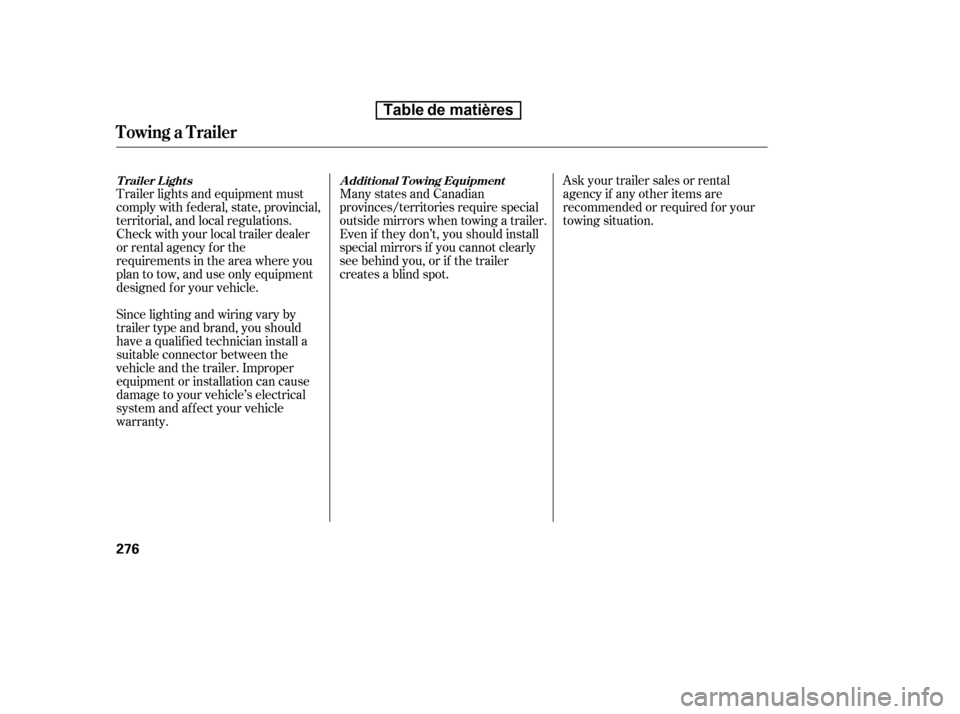
Trailer lights and equipment must
comply with f ederal, state, provincial,
territorial, and local regulations.
Check with your local trailer dealer
or rental agency for the
requirements in the area where you
plan to tow, and use only equipment
designed f or your vehicle.Many states and Canadian
provinces/territories require special
outside mirrors when towing a trailer.
Even if they don’t, you should install
special mirrors if you cannot clearly
see behind you, or if the trailer
creates a blind spot.Askyourtrailersalesorrental
agency if any other items are
recommended or required f or your
towing situation.
Since lighting and wiring vary by
trailer type and brand, you should
have a qualif ied technician install a
suitable connector between the
vehicle and the trailer. Improper
equipment or installation can cause
damage to your vehicle’s electrical
system and af f ect your vehicle
warranty.
A ddit ional T owing Equipment
T railer L ights
Towing a Trailer
276
Table de matières
Page 291 of 387

When preparing to tow, and bef ore
driving away, be sure to check the
f ollowing:Always drive slowly and have
someone guide you when backing up.
Grip the of the steering wheel,
then turn the wheel to the left to get
the trailer to move to the lef t, and
turn the wheel right to move the
trailer to the right.
Follow all normal precautions when
parking, including f irmly setting the
parking brake and putting the
transmission in Park (automatic) or
in 1st or reverse (manual). Also,
place wheel chocks at each of the
trailer’s tires.
Crosswinds and air turbulence
caused by passing trucks can disrupt
your steering and cause the trailer to
sway. When being passed by a large
vehicle, keep a constant speed, and
steer straight ahead. Do not try to
make quick steering or braking
corrections.
The vehicle has been properly
serviced, and the suspension,
cooling system, and lights are in
good operating condition.
All weights and loads are within
limits (see pages and ).
Thehitch,safetychains,andany
other attachments are secure.
All items in or on the trailer are
properly secured and cannot shif t
while you drive.
The lights and brakes on your
vehicle and the trailer are working
properly. Your vehicle tires and spare are
properly inf lated, and the trailer
tires and spare are inf lated as
recommended by the trailer
maker.
273 274
bottom
Pre-T ow ChecklistBacking Up
Parking
Handling Crosswinds and Buf f et ing
Towing a Trailer
Driving
277
Table de matières
Page 292 of 387
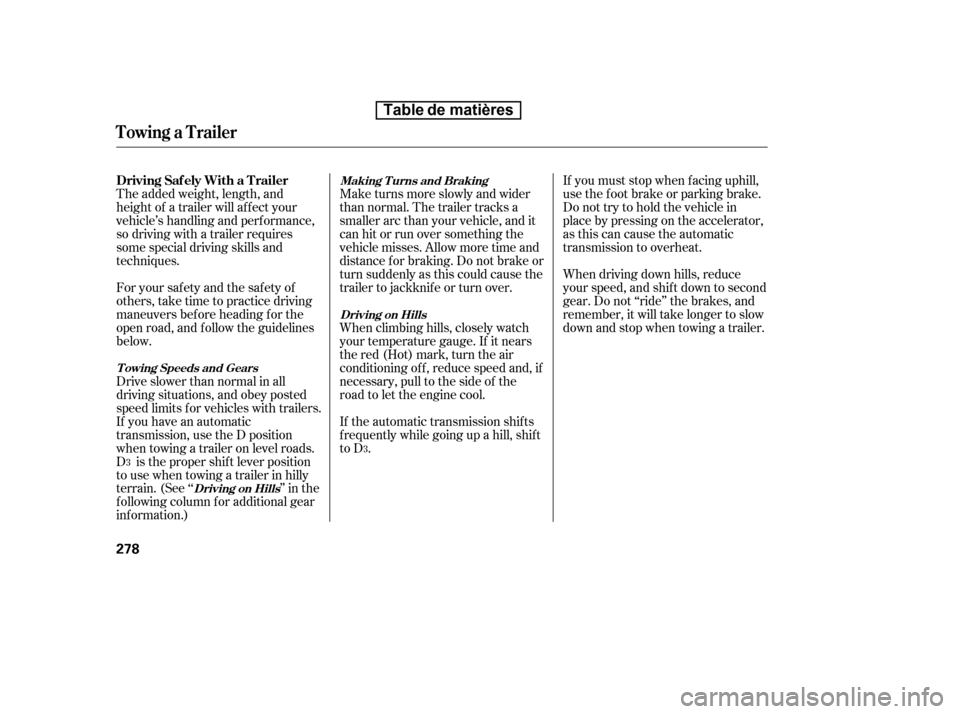
The added weight, length, and
height of a trailer will af f ect your
vehicle’s handling and perf ormance,
so driving with a trailer requires
some special driving skills and
techniques.
Foryoursafetyandthesafetyof
others,taketimetopracticedriving
maneuvers bef ore heading f or the
open road, and f ollow the guidelines
below.Maketurnsmoreslowlyandwider
than normal. The trailer tracks a
smaller arc than your vehicle, and it
canhitorrunoversomethingthe
vehicle misses. Allow more time and
distance f or braking. Do not brake or
turn suddenly as this could cause the
trailer to jackknif e or turn over.
When climbing hills, closely watch
your temperature gauge. If it nears
the red (Hot) mark, turn the air
conditioning of f , reduce speed and, if
necessary, pull to the side of the
road to let the engine cool.
If the automatic transmission shifts
f requently while going up a hill, shif t
to D .If youmuststopwhenfacinguphill,
use the f oot brake or parking brake.
Do not try to hold the vehicle in
place by pressing on the accelerator,
as this can cause the automatic
transmission to overheat.
When driving down hills, reduce
your speed, and shif t down to second
gear. Do not ‘‘ride’’ the brakes, and
remember, it will take longer to slow
downandstopwhentowingatrailer.
Drive slower than normal in all
driving situations, and obey posted
speed limits f or vehicles with trailers.
If you have an automatic
transmission, use the D position
when towing a trailer on level roads.
D is the proper shif t lever position
to use when towing a trailer in hilly
terrain. (See ‘‘ ’’ in the
f ollowing column f or additional gear
inf ormation.)
3
3
Driving Saf ely With a T railer
T owing Speeds and Gears Making T urns and Braking
Driving on Hills
Driving on Hills
Towing a Trailer
278
Table de matières
Page 339 of 387
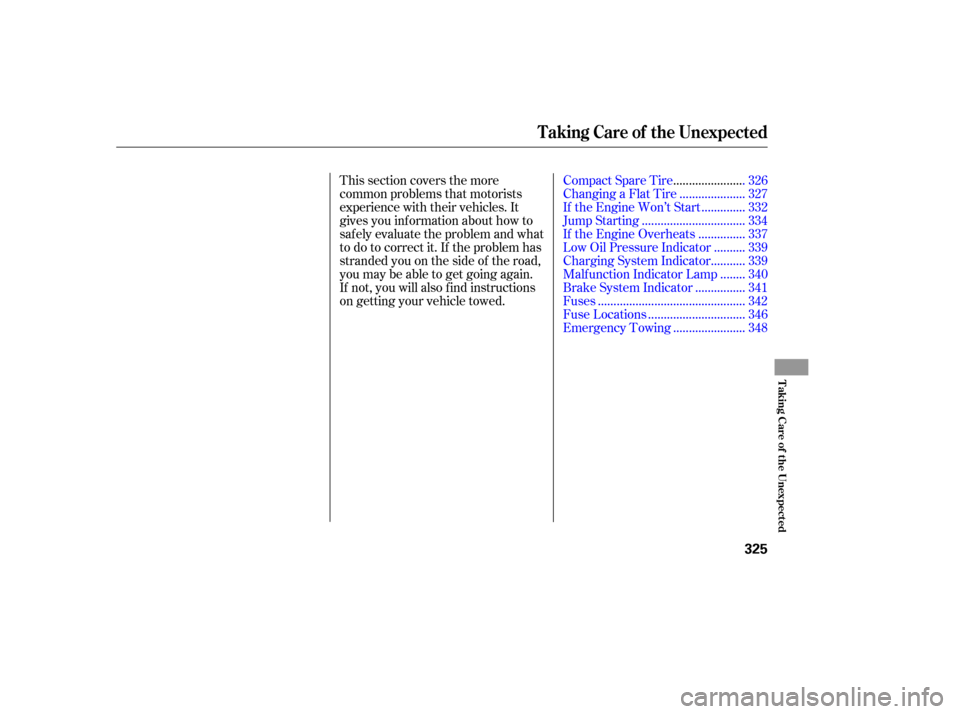
This section covers the more
common problems that motorists
experience with their vehicles. It
gives you inf ormation about how to
safely evaluate the problem and what
to do to correct it. If the problem has
stranded you on the side of the road,
you may be able to get going again.
If not, you will also f ind instructions
on getting your vehicle towed.......................Compact Spare Tire . 326
....................
Changing a Flat Tire . 327
.............
If the Engine Won’t Start . 332
................................
Jump Starting . 334
..............
If the Engine Overheats . 337
.........
Low Oil Pressure Indicator . 339
..........
Charging System Indicator . 339
.......
Malf unction Indicator Lamp . 340
...............
Brake System Indicator . 341
..............................................
Fuses . 342
..............................
Fuse Locations . 346
......................
Emergency Towing . 348
Taking Care of the Unexpected
T aking Care of t he Unexpect ed
325
Page 347 of 387
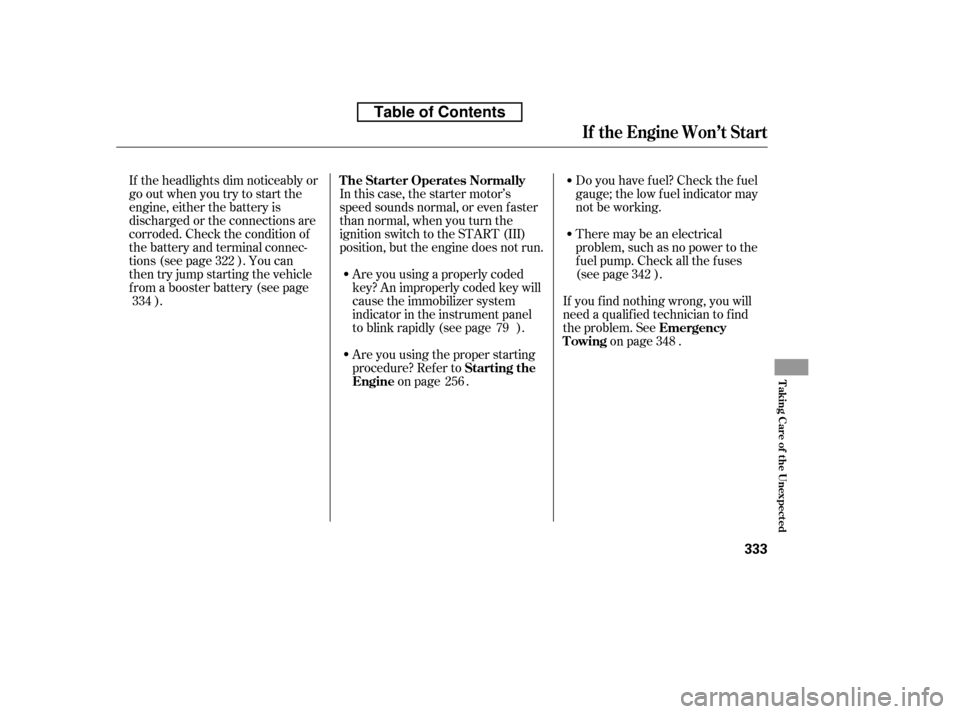
If youfindnothingwrong,youwill
need a qualif ied technician to f ind
the problem. Seeon page .
Do you have f uel? Check the f uel
gauge; the low f uel indicator may
not be working.
There may be an electrical
problem, such as no power to the
f uel pump. Check all the f uses
(see page ).
Are you using a properly coded
key? An improperly coded key will
cause the immobilizer system
indicator in the instrument panel
to blink rapidly (see page ).
Are you using the proper starting
procedure? Ref er to
on page .
In this case, the starter motor’s
speed sounds normal, or even f aster
than normal, when you turn the
ignition switch to the START (III)
position, but the engine does not run.
If the headlights dim noticeably or
go out when you try to start the
engine, either the battery is
discharged or the connections are
corroded. Check the condition of
the battery and terminal connec-
tions (see page ). You can
then try jump starting the vehicle
f rom a booster battery (see page
).
79
322
334
256342
348Emergency
Towing
Starting the
Engine
T he Starter Operates Normally
If theEngineWon’tStart
T aking Care of t he Unexpect ed
333
Table of Contents